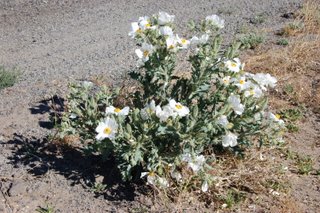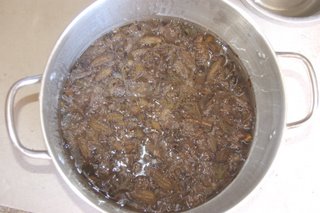
I couldn’t resist the look of Prickly Poppy. It’s such a prehistoric looking plant, with thorny stems and large flowers that look like fried eggs. I took the dogs with me in the truck to pick one pound of plant material. They ran all over while I delicately snipped pieces and parts into a five gallon bucket. Even with leather gloves, I got well acquainted with the origin of its name.
 In one book I read on dying with native plants, the list included colors from cooking as well as decomposition. So after I cooked the plants for one hour, I left them in the garage for a week, thinking that I could deepen the color of my results, which according to Anne Bliss, would be chartreuse. I don’t know if the color changed as it decomposed, but it certainly did decompose. Laura took one look in the pot and suggested that I toss the contents
In one book I read on dying with native plants, the list included colors from cooking as well as decomposition. So after I cooked the plants for one hour, I left them in the garage for a week, thinking that I could deepen the color of my results, which according to Anne Bliss, would be chartreuse. I don’t know if the color changed as it decomposed, but it certainly did decompose. Laura took one look in the pot and suggested that I toss the contents
As you can see, I didn’t get chartreuse.
While Laura was here, she solved a mystery for me. A couple of years ago we bought a fleece from Anna Harvey and split it. When she moved to





















1 comment:
Can we try to set up some natural dye extract experiments at the retreat at the end of September? I am so ready to get some color variety! Someone said yesterday at the fair that the natural dyes fade more readily, I know that many are equally colorfast. Don't give up yet! It was so great to meet you and Amy.
Post a Comment